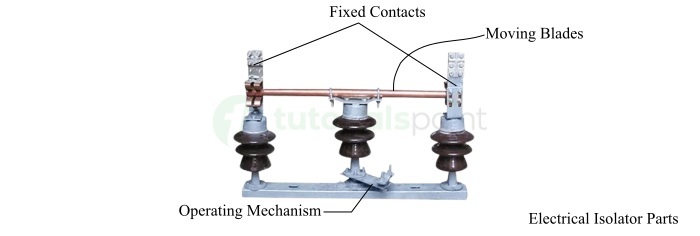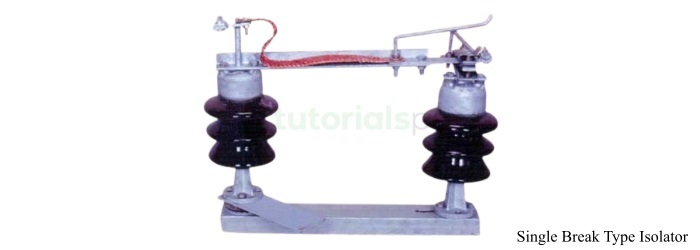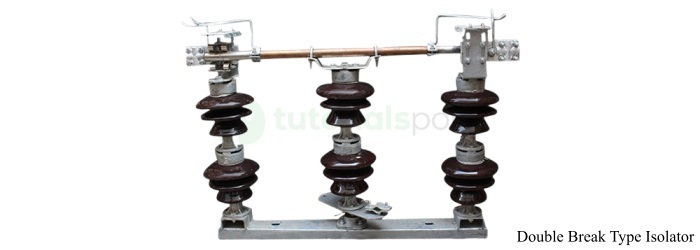
 Data Structure
Data Structure Networking
Networking RDBMS
RDBMS Operating System
Operating System Java
Java MS Excel
MS Excel iOS
iOS HTML
HTML CSS
CSS Android
Android Python
Python C Programming
C Programming C++
C++ C#
C# MongoDB
MongoDB MySQL
MySQL Javascript
Javascript PHP
PHP
- Selected Reading
- UPSC IAS Exams Notes
- Developer's Best Practices
- Questions and Answers
- Effective Resume Writing
- HR Interview Questions
- Computer Glossary
- Who is Who
What is an Electrical Isolator and why is it used?
In electrical power systems, an isolator is a type of switchgear device which is mainly used for ensuring that the circuit is completely disconnected from the source of power supply. Since its main function is to provide isolation in the circuit, hence it is termed as an isolator. However, it is also known as a disconnector. It is mainly used in substations, distribution feeders, industrial power supplies, etc.
By providing a visible disconnection in the circuit, isolators ensure the safety during maintenance work. Read this article to learn more about isolators, its types, working, advantages, limitations, and applications.
What is an Electrical Isolator?
An electrical isolator is an electrical switch that disconnects one part of an electric circuit from another and provides a visible separation at the point of isolation. It is a mechanical switch and is also known as a disconnector switch.
In an electrical circuit, isolators are primarily used for ensuring safety during maintenance work of the supply system. This is because, an isolator completely disconnects two segments of an electrical circuit and we can verify this isolation through the visible separation between the contacts of the isolator.
The most important thing that we must care while opening an isolator is that it must be opened under no-load condition, because it operates in air which is not much efficient in arc quenching. Thus, the blades and contacts of the isolator can get damaged due to arcing if it is opened under loaded condition.
Therefore, before opening the isolator, the circuit breaker must be opened and properly de-energize the power line.
Components of an Isolator
A typical isolator consists of the following main components
Moving Blades for opening and closing the circuit.
Fixed Contacts connects with the moving blades to complete the circuit.
Operating Mechanism to perform opening and closing operations of the blades.
These components of an isolator are depicted in the following figure.

Let us now understand the working of an isolator during its opening and closing operations.
How does an Electrical Isolator Work?
The operation of an isolator can be either manual or motorized, depending on the mechanism provided for it. In manual operation, a mechanical handle is used to open and close the contacts of the isolator. While in motorized operation, the isolator's contacts are closed or opened through an electric motor.
While operating an isolator it should be taken care that there is no arc quenching medium is provided. Hence, before operating the isolator, we must ensure that there is no current flowing through the circuit, otherwise it can damage the isolator permanently.
The opening and closing operations of an isolator are explained below in detail.
Opening of Isolator
The opening operation of an isolator is performed as follows
First of all, open the main circuit breaker.
Then, open the isolator switch using its operating handle or motorized mechanism.
Close the earth switch which acts as an interlock system for isolator.
Now, the line is completely isolated from the system and safe to work.
Closing of Isolator
The closing operation of the isolator is explained below
First of all, disconnect the earth switch.
Close the isolator's contacts using its operating mechanism.
Finally, close the circuit breaker to turn of the power supply.
Types of Electrical Isolators
Depending on the construction and application requirements, isolators can be classified into the following major three types
Single-Break Type Isolator
Double-Break Type Isolator
Pantograph Type Isolator
Let us discuss about each type of isolator in detail.
Single-Break Type Isolator
A typical single break isolator is shown in the following figure.

The following are some important points about single-break isolator
It has only a single contact for opening and closing the circuit.
It has simple construction.
It is easy to operate and repair.
It has a lesser number of components and is less expensive that other types of isolators.
It is suitable for low voltage applications only because it provides only a single break point in the circuit.
Double-Break Type Isolator
A double break isolator its circuit symbol is shown in the following figure.

The key points about a double break type isolator switch are given here
A double break type isolator consists of two separate contact points for opening and closing the circuit.
It provides better isolation in the circuit due to double breaking of the circuit.
It provides extra safety than single break isolator.
Double break isolator is relatively more complex in construction.
Due to greater number of components used, double break isolator is more expensive.
Pantograph Isolator
A pantograph type isolator is shown in the following figure.

The following are some important points describing a pantograph isolator
Pantograph isolators are used in high voltage applications.
The structure of these isolators is quite complex.
Pantograph isolators have a compact design which results in higher space efficiency.
The operation and maintenance of pantograph isolator is relatively difficult due to complex design.
In pantograph isolators, specialized components are used that make them more expensive among all types of isolators.
Maintenance of Isolators
In an electrical power system, isolators are important switchgear components that ensure safety during maintenance activities. Therefore, isolators have to be properly maintained to ensure their reliable operation.
Here are some key steps that we should take to maintain isolators
Regularly clean the body of the isolator to remove acid fumes, cement, salt, and any other kind of contamination. This is important for providing proper insulation.
Cleaning of the isolator must be done using a soft brush so that the components of the isolator do not get damaged.
Regularly inspect the isolator components for any defects. If any then repair or replace if required.
Tighten all the bolds and connections to avoid unwanted failure of the isolator.
Check the contact rod to ensure that it is properly aligned. A misaligned isolator rod can result in poor connection and arcing.
Lubricate all the moving parts to minimize the friction and wear.
Important Parameters for Selecting an Isolator
The following parameters play a vital role in selecting a right isolator for our application
System voltage level
Rated continuous current carrying capability
Short duration current capacity
Tripping and closing time of main circuit breaker
Open and close capacity of the main circuit breaker
Advantages of Isolators
The following are some key advantages and benefits of isolators
The open and close states of the isolators are visible that ensure safety.
The design and construction of isolators is simple and easy.
The installation of isolators in power lines is easy.
Isolators are relatively less expensive than other similar kinds of switchgear devices.
Isolators can provide both manual and motorized operation.
Isolators require very low maintenance.
Isolators can be customized as per the requirements of the applications.
The use of isolators in power system adds an extra layer of electrical safety.
Isolators can be used in a wide range of applications from low-voltage to high-voltage.
Limitations of Isolators
As mentioned above, isolators have numerous advantages. But they also come up with certain limitations which are given below
Isolators cannot be used for disconnecting an electrical circuit through which current is flowing. Instead, these can only be used for breaking circuits under no-load conditions.
Most isolators have manual operation which is inconvenient and not safe in all situations.
Isolators are susceptible for environmental conditions like dust, moisture, salt, acidic fumes, etc.
Isolators have moving components, hence there is also mechanical wear and tear.
Manual isolators can have improper disconnection and reconnection issues due to human errors.
Applications of Isolators
The main function of an isolator is to disconnect an electrical circuit and provide a visible separation between the isolated segments to ensure safety during maintenance work. Isolators are commonly used for this purpose in the following
Electrical power distribution networks
Electrical substations
In electrical switchgear assemblies to disconnect them from the circuit for maintenance and repair
Railway electrification systems for isolating overhead lines, etc.
Conclusion
An isolator is a no-load device used in power lines and substations for isolating a part of network from the complete network. It is a no-load device because it can only be operated when no current is flowing through circuit. This is because there is no arc quenching mechanism is provided in the isolator.
The primary purpose of using an isolator in an electrical network is to add extra layer safety during maintenance work because isolator provides a visible separation between the sections of the circuit. It is widely used in substations and distribution networks.

